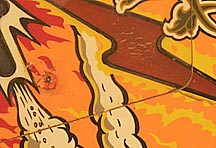

Wayne Schmidt's Mylar Removal Page Comparing five different removal techniques.
While
I accept that Mylar is necessary to prolong the life of a pinball
playfield in commercial service, I really don't like it because the
edges collect dirt and end up looking like black lines drawn through
the artwork. The picture below of an Addams Family playfield shows
what I mean:

For most home games the amount of use isn't high enough to require this level of protection. Besides the black-line problem this playfield also had several screws that had been driven all the way through the board that needed repair. Since this requires removing the Mylar I decided to use this opportunity to compare as many Mylar removal techniques I could find to determine which was the easiest.
1.
Simple Peel Technique:
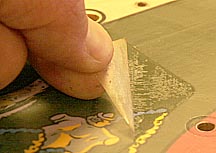
Although the Mylar on this TAF playfield is over 16 years old the adhesive is still fresh enough to peel off without any softening procedure. Using a fingernail at a corner, I was able to scrap up enough of the edge to grab. The adhesive held tight but a steady tension slowly pulled the Mylar up. Note the adhesive left behind on the playfield.
Although considerable pull is required with this technique the underlying paint never gave the slightest indication of breaking loose. Older Mylar applied over playfields with less well adhered paint might pull some of it up, so be careful is using this technique.
2.
Hair Drier Technique:
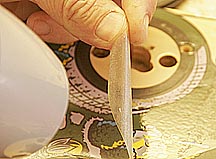
Warming the Mylar with a hair drier softens the adhesive so it's easier to pull up. I found that doing so made it four times easier to pull the Mylar up than with the first technique. This greatly reduces the likelihood of pulling up paint.
3.
Freezing Technique:
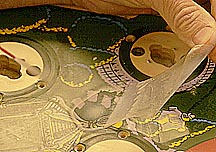
Radio Shack sells cans of coolant used to locate circuit components that fail when they get warm. Using it to freeze the Mylar adhesive eliminates the adhesive's stickiness and the Mylar pulls off with little or no effort. This is undoubtedly the fastest way to remove the plastic part of the Mylar applique. Unfortunately, like the previous two techniques it still leaves adhesive on the playfield that has to be removed with solvent.
One can of coolant was more than enough to removal all the Mylar from one Addams Family game playfield.
4.
Goo Gone Technique:
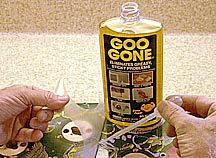
Using a pipet, I applied Goo Gone to the edge of the Mylar, let it soak in a few seconds and then gently pulled it up, applying more Goo Gone every quarter inch. Placing the playfield on a slight incline helps keep the Goo Gone concentrated against the edge of the Mylar.
The Mylar pulls away about as easily as with the hair drier technique. Although using Goo Gone makes the process a little messy, though not as much as you might imagine, it has the great advantage of completely dissolving the adhesive. Wiping the area clean with a paper towel every inch or so removes all the residue.
4.
Goo Gone Extreme Technique:
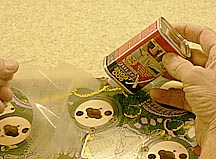
This is the same as the previous technique accept Goo Gone Extreme is used instead of the original Goo Gone. The "Extreme" has a different formula and I thought it might work better. It didn't. Goo Gone Extreme failed to dissolve the adhesive as completely as the original Goo Gone and left a lot of gummy residue.
Conclusions:
After comparing all five techniques I have to state a preference for #4, the Goo Gone method. The simple peel, hair drier and cold spray techniques leave an adhesive residue that is difficult and time consuming to remove. (I tested Goo Gone, Goo Gone Extreme, Mineral spirits and Naptha to remove this residue and none of them worked very well, though eventually they all got the job done.) Using the Goo Gone technique creates a thicker layer of Goo Gone on the adhesive that remains in contact with it for a longer time, which somehow more completely dissolves it. Although the cold spray technique gets the Mylar plastic off the easiest and fastest, because the residue takes so much time and effort to remove the Goo Gone technique actually ends up being the fastest.
Note that Goo Gone leaves an oily residue of its own so always follow its usage with a Naptha wipedown.
(Click on main site to browse 70 other topics ranging from exotic kaleidoscope designs to the strange world of lucid dreaming. There you will also find several other pages dealing with the Addams Family pinball game.)